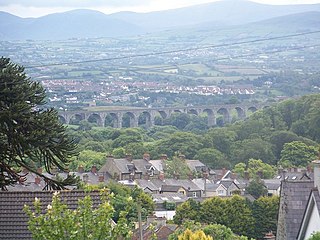
Belfast is the capital city and principal port of Northern Ireland, standing on the banks of the River Lagan and connected to the open sea through Belfast Lough and the North Channel. It is the second-largest city on the island of Ireland, with an estimated population of 348,005 in 2022, and a metropolitan area population of 671,559.

The Troubles were an ethno-nationalist conflict in Northern Ireland that lasted for about 30 years from the late 1960s to 1998. Also known internationally as the Northern Ireland conflict, it began in the late 1960s and is usually deemed to have ended with the Good Friday Agreement of 1998. Although the Troubles mostly took place in Northern Ireland, at times violence spilled over into parts of the Republic of Ireland, England, and mainland Europe.
Sectarianism is a debated concept. Some scholars and journalists define it as pre-existing fixed communal categories in society, and use it to explain political, cultural, or religious conflicts between groups. Others conceive of sectarianism as a set of social practices where daily life is organized on the basis of communal norms and rules that individuals strategically use and transcend. This definition highlights the co-constitutive aspect of sectarianism and people's agency, as opposed to understanding sectarianism as being fixed and incompatible communal boundaries.

The University of Wollongong (UOW) is an Australian public research university located in the coastal city of Wollongong, New South Wales, approximately 80 kilometres (50 mi) south of Sydney. As of 2023, the university had an enrolment of more than 33,000 students, an alumni base of more than 176,000 [LC1] and over 2,400 staff members including 16 Distinguished professors.

Sectarian violence or sectarian strife is a form of communal violence which is inspired by sectarianism, that is, discrimination, hatred or prejudice between different sects of a particular mode of an ideology or different sects of a religion within a nation or community. Religious segregation often plays a role in sectarian violence.

Bessbrook is a village in County Armagh, Northern Ireland. It lies about three miles (5 km) northwest of Newry and near the Newry bypass on the main A1 Belfast-Dublin road and Belfast-Dublin railway line. Today the village of Bessbrook straddles the three townlands of Maghernahely, Clogharevan and Maytown. Bessbrook is near Newry railway station. It had a population of 2,892 at the 2021 Census. The model village of Bessbrook, County Armagh is a visible memorial to the commercial endeavours of the Richardson family over a number of generations.
The Bogside is a neighbourhood outside the city walls of Derry, Northern Ireland. The large gable-wall murals by the Bogside Artists, Free Derry Corner and the Gasyard Féile are popular tourist attractions. The Bogside is a majority Catholic/Irish republican area, and shares a border with the Protestant/Ulster loyalist enclave of the Fountain.

The Twelfth is a primarily Ulster Protestant celebration held on 12 July. It began in the late 18th century in Ulster. It celebrates the Glorious Revolution (1688) and victory of Protestant King William of Orange over Catholic King James II at the Battle of the Boyne (1690), which ensured a Whig political party and Anglican Ascendancy in Ireland and the passing of the Penal Laws to disenfranchise and persecute the nation's Catholic majority, and to a lesser extent Protestant Dissenters, until Catholic Emancipation in 1829.

Forkhill or Forkill is a small village and civil parish in south County Armagh, Northern Ireland. It is within the Ring of Gullion and in the 2011 Census it had a recorded population of 498. The population increased to 550 at the time of the 2021 Census.

The Loyal Orange Institution, commonly known as the Orange Order, is an international Protestant fraternal order based in Northern Ireland and primarily associated with Ulster Protestants. It also has lodges in England, Scotland, Wales and the Republic of Ireland, as well as in parts of the Commonwealth of Nations and the United States.

John Harold Hewitt was perhaps the most significant Belfast poet to emerge before the 1960s generation of Northern Irish poets that included Seamus Heaney, Derek Mahon and Michael Longley. He was appointed the first writer-in-residence at Queen's University Belfast in 1976. His collections include The Day of the Corncrake (1969) and Out of My Time: Poems 1969 to 1974 (1974). He was also made a Freeman of the City of Belfast in 1983, and was awarded honorary doctorates by the University of Ulster and Queen's University Belfast.
Thomas Robert Frame is an Australian academic, author and Anglican priest. He was formerly the Anglican Bishop to the Australian Defence Force from 2001 to 2007.
Ramingining is an Aboriginal Australian community of mainly Yolngu people in the Northern Territory, Australia, 560 kilometres (350 mi) east of Darwin. It is on the edge of the Arafura Swamp in Arnhem Land. Wulkabimirri is a tiny outstation (homeland) nearby, and Murwangi, further south, is part of the Ramingining Homelands. Marwuyu Gulparil, also known as Gulparil Marwuyu or just Marwuyu, is another remote community to the south of Ramingining.
The economy of Belfast, Northern Ireland was initially built on trade through Belfast Harbour. Later, industry contributed to its growth, particularly shipbuilding and linen. At the beginning of the 20th century Belfast was both the largest producer of linen in the world and also boasted the world's largest shipyard. Civil unrest impacted the city's industry for many years, but with the republican and loyalist ceasefires of the mid-1990s, Good Friday Agreement and the St Andrews Agreement in 2006, the city's economy has seen some resurgence once again.

Robert Marsden Hope, was a Justice of the New South Wales Court of Appeal and Royal Commissioner on three separate occasions, most notably the Royal Commission on Intelligence and Security. As a judge Hope was known for his legal positivism and as a royal commissioner he "instilled a sense of impartiality".
Sectarianism can be defined as a practice that is created over a period of time through consistent social, cultural and political habits leading to the formation of group solidarity that is dependent upon practices of inclusion and exclusion. Sectarian discrimination focuses on the exclusion aspect of sectarianism and can be defined as 'hatred arising from attaching importance to perceived differences between subdivisions within a group', for example the different denominations of a religion or the factions of a political belief.
Janet Lynn Morton is a Canadian visual artist who is known for her knitted works.
Siobhán McHugh is an Irish-Australian author, podcast producer and critic, oral historian, audio documentary-maker and journalism academic. In 2013 she founded RadioDoc Review, the first journal of critical analysis of crafted audio storytelling podcasts and features, for which she received an academic research award. She is Associate Professor of Journalism (honorary) at the University of Wollongong (UOW). and Associate Professor of Media and Communications (honorary) at the University of Sydney. Her latest book, The Power of Podcasting: telling stories through sound, was published by NewSouth Books in February 2022, with a US edition through Columbia University Press in October 2022.
Sally Robinson is an English-born Australian artist. She has had a long career as a portrait artist and designer, painter and printmaker, teacher and lecturer. Her work is represented in private and public collections around Australia.
Jutta Feddersen was a German-born Australian fibre artist, sculptor, lecturer.










